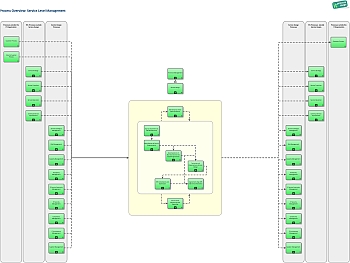Service Level Management
| diese Seite auf Deutsch |
|---|
ITIL Version: ITIL Version 3 (ITIL V3)
Process Objective: To negotiate Service Level Agreements with the customers and to design services in accordance with the agreed service level targets. Service Level Management is also responsible for ensuring that all Operational Level Agreements and Underpinning Contracts are appropriate, and to monitor and report on service levels.
Part of: Service Design
Process Owner: Service Level Manager
ITIL V3 vs. ITIL V2: Service Level Management
- Essentially, the activities and process objectives of the Service Level Management process are identical in ITIL V2 and V3
- In ITIL V3, the Service Review activities are part of Continual Service Improvement
Sub-Processes of Service Level Management (ITIL V3)

- Maintenance of the SLM Framework
- Process Objective: To design and maintain a structured catalogue and framework for Service Level Agreements, and to provide templates for the various SLM documents.
- Sign up Customers to Standard Services
- Process Objective: To capture customer requirements and agree service level targets with customers who request the provision of existing standard services (no modifications to existing Supporting Services are necessary in order to fulfill the customer's needs).
- Identification of Service Requirements
- Process Objective: To capture desired outcomes (requirements from the customer viewpoint) for new services or major service modifications. The requirements are to be documented and submitted to an initial evaluation, so that alternatives may be sought at an early stage for requirements which are not technically or economically feasable.
- Decomposition of Business Service into Supporting Services
- Process Objective: To determine the Supporting Services which will be used to deliver a Business Service, and to find out where the Supporting Services must be modified in order to provide the required service levels and functionality.
- Technical and Organizational Service Design
- Process Objective: To determine how a new service will be provided from an IT perspective. In particular, this means to specify any technical infrastructure to be created, as well as required organizational changes. The resulting Service Design Package contains all relevant information for Service Transition.
- RFC Compilation and Submission
- Process Objective: To initiate the implementation of a new service by preparing a formal Request for Change.
- Agreements Sign-Off and Service Activation
- Process Objective: To have all relevant contracts signed off after completion of Service Transition, and to check if Service Acceptance Criteria are fulfilled. In particular, this process makes sure that all relevant OLAs are signed off by their Service Owners, and that the SLA is signed off by the customer.
- Service Level Monitoring and Reporting
- Process Objective: To monitor achieved service levels and compare them with agreed service level targets. This information is circulated to customers and all other relevant parties, as a basis for measures to improve service quality.
Related Key Performance Indicators






